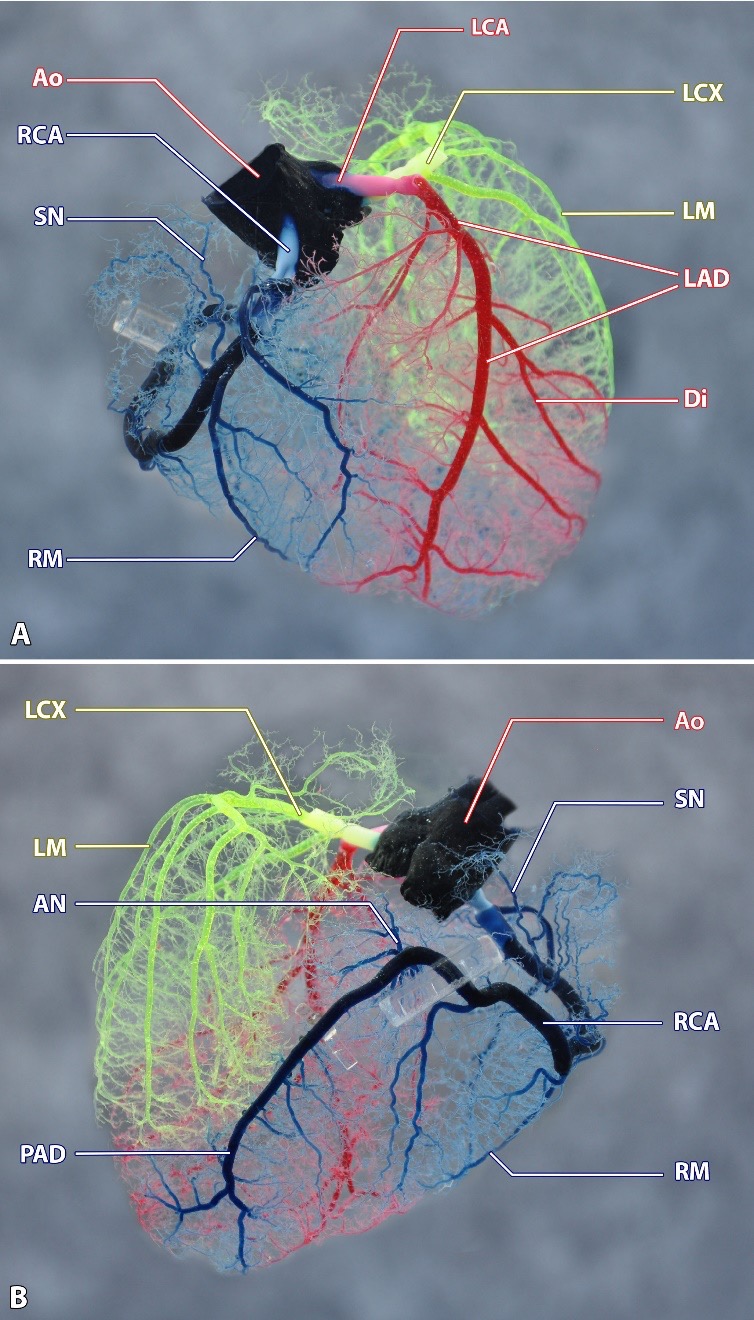Tissue Elimination of Large Vascular Corrosion Casting for Anatomy Education
DOI:
https://doi.org/10.33192/Smj.2022.89Keywords:
Coronary artery, Angiography, Saponification, Alkaline liquefaction, Sus scrofa domesticusAbstract
Objective: Vascular corrosion casting is crucial tool for three-dimensional study. Focusing on the casting for gross anatomy, large fatty tissue reacts with corrosive agents resulting in extensive saponification. Our study aimed to prevent saponification by a) finding the optimal corrosion temperature and concentration of corrosive agent and b) comparing the flow of the agent with conventional “non-flow” setting.
Materials and Methods: Phase I: pig fatty tissues, weighing 10 g each, were immersed in still (non-flowing) solution containing 0.5%, 1%, and 5% sodium hydroxide. Different temperatures were set to find the minimum soap-free temperature for each concentration. Phases II, III: 6 pig hearts were injected via the coronary arteries with polymethyl methacrylate. Three hearts were immersed in non-flowing 0.5%, 1%, and 5% NaOH solution, while another three were placed in a flowing solution. The flow was set in a vertical upward fashion in a specialized chamber while the outflow residue was collected from the system. The temperature was set at the minimum soap-free temperature. The durations of the corrosion were compared.
Results: The minimum soap-free temperatures for the 0.5%, 1%, and 5% concentrations were 55°C, 54°C, and 47°C, respectively. The corrosion times for the non-flowing 0.5%, 1%, and 5% concentrations were 216 h, 114 h, and 24 h, respectively. Flowing of the solution reduced the corrosion time by 25%-39% compared with the non-flowing.
Conclusion: The most efficient condition for soap-free coronary corrosion casting is 5% NaOH solution at a minimal temperature of 47°C.
References
Johnson M. Evaluation of Learning Style for First Year Medical Students. International Journal Scholarship of Teaching & Learning. 2009;3(1). Available from: https://doi.org/10.20429/ijsotl.2009.030120
Lombardi SA, Hicks RE, Thompson KV, Marbach-Ad G. Are all hands-on activities equally effective? Effect of using plastic models, organ dissections, and virtual dissections on student learning and perceptions. Adv Physiol Educ. 2014;38(1):80-86.
Grabherr S, Cadas H, Riederer BM, Charlier P, Djonov V. Postmortem Angiography: A Historical Review. In: Grabherr S, Grimm JM, Heinemann A, editors. Atlas of Postmortem Angiography. Cham: Springer International Publishing; 2016. p.53-70.
Verli FD, Rossi-Schneider TR, Schneider FL, Yurgel LS, de Souza MAL. Vascular Corrosion Casting Technique Steps. Scanning. 2007;29(3):128-32.
Prozorowska E, Jackowiak H. The vascular corrosion casting (VCC) and scanning electron microscopy study on changes of vascular networks arrangement in the organs undergoing cyclic volume changes. Microscopy: advances in scientific research education 6th ed Badajoz, Spain: Formatex Research Center. 2014.p.112-18.
Walocha J, Litwin JA, Miodoński AJ. Corrosion casting technique. In: Schatten H, editor. Scanning Electron Microscopy for the Life Sciences. Cambridge: Cambridge University Press; 2012. p.16-32.
Abdel-Wahab AA, Ataya S, Silberschmidt VV. Temperaturedependent mechanical behaviour of PMMA: Experimental analysis and modelling. Polymer Testing. 2017;58:86-95.
Shanthini S, Suma HY. An innovative method in venous coronary cast technique. Anat Cell Biol. 2019;52(2):191-5.
Kupczyńska M, Barszcz K, Olbrych K, Polguj M, Wysiadecki G, Topol M, et al. Coronary arteries of the European bison (Bison bonasus). Acta Veterinaria Scandinavica. 2015;57:1-7.
Gupta PK. Chapter 23 - Toxic effects of caustics (corrosives). In: Gupta PK, editor. Fundamentals of Toxicology: Academic Press; 2016.p.267-75.
Zheng JL, Zhu MQ, Wu HT. Alkaline hydrothermal liquefaction of swine carcasses to bio-oil. Waste Manag. 2015;43:230-8.
Wang T, Wu J-H, Yi Y, Qi J-C. Optimization of Process Conditions for Infected Animal Tissues by Alkaline Hydrolysis Technology. Procedia Environmental Sciences. 2016;31:366-74.
Ratanalekha R. Development of Vascular Corrosion Casting for Education in Gross Anatomy. In: Laohaprasitthiphorn D, editor. Outstanding Innovation, Quality Fair, 2018, Faculty of Medicine Siriraj Hospital, Mahidol University. Bangkok, Thailand: Division of Quality Development, Faculty of Medicine Siriraj Hospital, Mahidol University; 2018.p.136-40.
Spitz L. Glossary. In: Spitz L, editor. Soap Manufacturing Technology. United Kingdom: Elsevier Inc; 2016.p.267-80.
McBain JW, Sierichs WC. The solubility of sodium and potassium soaps and the phase diagrams of aqueous potassium soaps. Journal of the American Oil Chemists Society. 1948;25(6):221-5. Available from: https://doi.org/10.1007/BF02645899
Hall N. Implications of Soap Structure for Formulation and User Properties. In: Spitz L, editor. Soap Manufacturing Technology. United Kingdom: Elsevier Inc; 2016.p.1-33.
Lin B, McCormick AV, Davis HT, Strey R. Solubility of sodium soaps in aqueous salt solutions. J Colloid Interface Sci. 2005;291(2):543-9.
Hill M, Moaddel T. 2 - Soap Structure and Phase Behavior. In: Spitz L, editor. Soap Manufacturing Technology (Second Edition): AOCS Press; 2016.p.35-54.
Kingsbury KJ, Paul S, Crossley A, Morgan DM. The fatty acid composition of human depot fat. Biochem J. 1961;78(3):541-50.

Published
How to Cite
Issue
Section
License

This work is licensed under a Creative Commons Attribution-NonCommercial-NoDerivatives 4.0 International License.
Authors who publish with this journal agree to the following conditions:
Copyright Transfer
In submitting a manuscript, the authors acknowledge that the work will become the copyrighted property of Siriraj Medical Journal upon publication.
License
Articles are licensed under a Creative Commons Attribution-NonCommercial-NoDerivatives 4.0 International License (CC BY-NC-ND 4.0). This license allows for the sharing of the work for non-commercial purposes with proper attribution to the authors and the journal. However, it does not permit modifications or the creation of derivative works.
Sharing and Access
Authors are encouraged to share their article on their personal or institutional websites and through other non-commercial platforms. Doing so can increase readership and citations.














